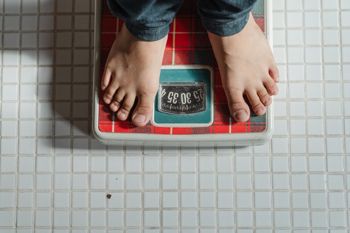You know that when you sit too long, it’s not good for you.
You may have even heard that “sitting is the new smoking” because of how it increases your risk for overweight, type 2 diabetes, and heart disease.
But you exercise 30-60 minutes a day. You eat healthy foods most of the time. You get 7-8 hours of sleep most nights.
So even if you sit more than you should, you’ll be fine, right?
A lot of people think this way. After all, it’s not easy to avoid a lot of sitting, so we tend to rationalize it away.
To help you break the habit, I’ve listed below fifteen things that happen to your body when you sit for too long—and even this is not an exhaustive list.
What qualifies as “too long” anyway? You’ll find the answer to that too, along with some advice on how to limit your sitting time—for the sake of your physical and mental health.
15 Health Effects That Can Occur When You Sit Too Long
 1. Back Pain and Neck Pain
1. Back Pain and Neck Pain
Most writers are intimately familiar with these, as they’ve experienced them at one point or another.
When you sit, you compress the spine. Gravity presses down from above while the chair offers resistance from below, squeezing the discs between the vertebrae.
Meanwhile, the muscles that typically support your back—the leg, hip, and gluteus (bottom) muscles—become shortened and tight, so they pull on your back, increasing pressure on the spine.
Of course, most of us don’t maintain good posture while we’re sitting, slumping into a slouched, curved-back position with our heads jutting forward. This not only puts additional pressure on the neck and upper spine but further compresses the entire spine, potentially leading to premature degeneration of the discs in the back and neck.
After just an hour of sitting without a break, the muscles along the back and legs that you use to maintain your posture start to get tired and lose their ability to support you properly. Similarly, the muscles in your neck and shoulders will also become fatigued, encouraging you to slouch.
All these factors increase your odds of suffering from neck and back pain caused by tight and weak muscles, as well as spinal issues like a herniated disc, inflammation, and back arthritis.
Sit Too Long #2. Shoulder Pain
All the elements mentioned above can affect your shoulders, too. You may try to maintain good posture, but the longer you sit, the more your muscles tire until you slump into a slouch. This forces your shoulder blades to tip forward and curl inward, creating a strain on the shoulders that leads to pain.
If you, like many writers, spend hours at the computer day after day and year after year, you can eventually adopt a permanent slouched posture that alters the way your shoulders function, making it harder to lift your arms above your head. At this point, you may suffer from more consistent, chronic pain—all caused by excessive sitting.
3. Joint Pain
It’s not uncommon for writers, particularly as they approach middle-age and beyond, to complain of not only back and neck pain, but hip and knee pain, too. These are also caused by too much sitting. The muscles around the joints become tight, pulling on the joints and increasing strain, while the joint itself lacks the movement it needs to maintain lubrication and flexibility.
Over time, as your joints suffer day in and day out, your risk of chronic joint pain increases. This is the type of pain that stays with you throughout the day, whether you’re writing or not.
Sit Too Long #4. Decreased Blood Flow
As your muscles tire and you remain in your chair, blood flow to your lower extremities begins to decrease. Researchers reported in 2011 that sitting for long periods could cause reduced blood flow, particularly in the legs. This can increase the risk for blood clots that lead to pulmonary embolism (blood clot in the lung), a potentially life-threatening condition.
The risk of pulmonary embolism was more than twofold in women who spent the most time sitting (more than 40 hours a week—not hard to do!) compared to those who spent the least.
All this sitting can also increase the risk for varicose veins. These swollen veins are unsightly and in rare cases, can lead to blood clots.
 5. Confusion and Lack of Focus
5. Confusion and Lack of Focus
If, after writing for a time, you find that you can’t focus as well as you did at the beginning of your writing session, it may be because all that sitting has reduced your intake of oxygen.
When you’re sitting down—particularly when you adopt a slumped position—your lungs have less space in which to expand as you breathe, so they don’t take in as much oxygen.
You are also likely to take more shallow breaths while sitting. After a time, you may experience symptoms of low oxygen like lightheadedness, confusion, and shortness of breath. This lower oxygen intake can also cause you to feel prematurely tired or sluggish, like you don’t have the energy to keep writing.
Meanwhile, remember that the longer you sit, the less blood circulates around your body, which means less gets to your brain, as well. A decreased blood flow results in forgetfulness and foggy thinking, as the brain struggles to operate without an adequate blood supply.
This may be one of the reasons excessive sitting habits have been connected with reducing processing speed and your ability to plan and organize.
Want to get past a sticky plot point? Get up and walk around!
6. Indigestion
If you’ve been experiencing more stomach problems lately, it could be all that sitting. Remaining at your desk or in your easy chair for hours at a time compresses your abdomen as well as your lungs, and can increase the chances that you’ll suffer from gas, cramps, bloating, and heartburn, particularly after eating.
Studies have found that our posture after eating can affect digestion. In 2002, researchers reported that participants who lay on their backs after eating a meal digested that meal more quickly than those who sat in a chair after eating. (Slower digestion typically results in side effects like gas and bloating.) The sitters did not absorb carbohydrates as well, either. The carbs were more likely to sit and ferment in the colon, causing digestive discomfort.
Walking after eating, on the other hand, has been found to help speed up the time it takes food to move from the stomach into the small intestines, improving digestion and satiety and decreasing the risk of heartburn and other digestive issues. It also helps draw glucose out of the bloodstream to deliver it to the muscles, lowering overall blood sugar levels.
Sit Too Long #7. Weak Bones
To stay strong, your bones need weight-bearing exercises such as standing, walking, and jogging. These activities stress your bones and encourage the body to replace old bone tissue with new, making your bones stronger.
When you sit too much, the body gets lazy about replacing bone tissue, and your bones become weaker and more fragile. This increases your risk of osteoporosis and bone fractures, particularly as you get older.
 8. Overweight
8. Overweight
Writers know how easy it is to gain weight while working. We tend to munch on unhealthy snacks as we write, and that combined with the inactivity tilts the scale toward more calories and increased fat storage.
The problem goes further than that, though. The more you sit, the less the hormone insulin moves glucose out of your blood and into your cells. That can increase your risk for high blood sugar levels and pre-diabetes or even full-out type 2 diabetes.
Sitting can also change how you metabolize fat, encouraging your body to use less and store more. All of these effects lead to weight gain, which increases your risk of many diseases, including heart disease, type 2 diabetes, and some forms of cancer.
9. Cancer
It seems everything increases the risk of cancer, right? But sitting too long is particularly dangerous because it can lead to inflammation, weight gain, and other changes that set the stage for cancerous growth.
In a 2014 review, scientists found that for every additional two hours per day sitting, the participants’ risk for colon cancer increased by 8 percent, and their risk for endometrial cancer increased by 10 percent.
Sit Too Long #10. Depression
It’s not just your body that suffers from sitting too long—your emotional state does, too.
In a 2013 study of over 3,000 state government employees, researchers found that the more employees sat at work, the greater their risk for depression, even if they exercised regularly. More specifically, those sitting for less than 3 hours a day were happier than those sitting for more than 6 hours per day.
11. Dementia
Recent research has found that while sitting too much increases your risk of heart disease, it can also increase your risk for Alzheimer’s disease and other forms of dementia.
Scientists performed brain scans on volunteers, then compared them with reported daily sitting times. They found that more sitting was related to a thinning of the medial temporal lobe (MTL), which is involved in the formation of new memories. In turn, MTL thinning is known to be a potential precursor to cognitive decline and dementia in middle-aged and older adults.
12. Insomnia
Daily exercise is known to help you sleep better. On the other hand, if you’re sitting too much, it will be harder to get that 7-8 hours of recommended sleep at night, which can increase your risk of associated health problems like obesity, type 2 diabetes, and heart disease, say nothing of how a lack of sleep affects your thinking and creativity.
Research has found that leading a generally sedentary life—where you sit several hours a day—is associated with an increased risk of restless, insufficient sleep and insomnia.
 13. Headaches
13. Headaches
Suffering from recurrent headaches? Don’t know why? Could be you’re sitting too much.
When you’re sitting, you’re likely to slouch, putting extra pressure on your neck and spine. This creates tension in the back and neck, which can lead to headaches.
Add to that the fact that you’re probably staring at a screen, which over time, can increase the risk of headaches because of the glare and associated eye strain.
These actions can trigger migraines if you’re susceptible to them, particularly if you’re working under the glow of fluorescent lights, which have been known to trigger migraines in sensitive individuals.
14. Heart Disease
Heart disease remains the number-one killer of both men and women, and we all increase our risk by sitting too much.
All the things that happen to your body because of excessive sitting—weight gain, increase in blood sugar levels and blood pressure, inflammation, etc.—lead you down the path to heart disease.
In a 2009 study, researchers found that men who spent more than 23 hours per week watching television (add up your hours!) had a 64 percent greater risk of dying from cardiovascular disease than men who watched only 11 hours.
Researchers from the Toronto Rehabilitation Institute also found that sitting time was associated with a higher risk of all-cause of mortality, including from heart disease.
According to a science advisory from the American Heart Association (AHA), too much sedentary time increases the risk of cardiovascular disease, diabetes, and death, even if you exercise regularly.
The AHA estimated that most U.S. adults spend six to eight hours a day sitting, driving, reading, watching television, and working on the computer.
15. Death
All the negative changes that occur in your body and brain with excessive sitting increase your risk for one very concerning outcome: premature death.
The American Cancer Society reports that there is a strong link between long periods of leisure time sitting and a higher risk of death from all causes, including cancer, heart disease, stroke, diabetes, Parkinson’s disease, Alzheimer’s disease, digestive diseases, and more.
 How Much Sitting is Too Much?
How Much Sitting is Too Much?
So far we don’t have an official figure as to how many hours of sitting are too many. We need more research to narrow it down, but from what we know so far, most adults sit from 6-8 hours a day, which is considered to be too much and is the amount associated with disease.
Currently, health experts recommend that we work toward cutting our total sitting time by two hours at first, gradually shooting for four fewer hours of sitting a day. Studies have shown that even a small increase in non-sitting activity can decrease the risk of health problems.
The greatest risk reduction was observed in those incorporating four or more hours of non-sitting activity per day. This amount increased energy, lowered glucose and insulin levels, improved muscle function, and decreased joint pain.
Below are several tips to help you incorporate more non-sitting time into your day. Before you start, take a few days to keep a log of how many hours you typically sit. We all tend to underestimate this figure. Add in all the time you spend sitting at work, while commuting, eating, relaxing, and writing. Note your total, and then determine by how many hours you need to reduce your sitting time.
 10 Ways to Protect Yourself from the Dangers of Too Much Sitting
10 Ways to Protect Yourself from the Dangers of Too Much Sitting
Below are ten habits that will help protect you from the dangers of too much sitting while allowing you to get your work—and your writing—done!
Set an alarm.
Get up every 30 minutes and walk around, no exceptions! Just a quick 3-5 minute break can have multiple benefits, including stretching your muscles, improving blood flow, waking up your brain, and easing pressure on your spine.
Exercise 60-75 minutes a day.
Movement is key to reducing the negative effects of sitting, so exercise as much as you can. Remember you can break it up into shorter periods—an approach that’s considered by many to be healthier than a one-time shot. Try doing your regular workout in the morning, then take a walk after lunch and dinner. (This may help you lose weight, too!)
Create “get up” triggers.
From what we know so far, the main problem is sitting for extended periods without moving. Some research has suggested that getting up more often can counteract the negative effects of sitting. You can do that by creating “triggers” that compel you to get up. Examples include: get up to talk on the phone, get up during commercials, get up at the end of each scene you write, get up at the top of each hour, get up to read a text message, etc.
Use a standing desk.
I don’t advise that you stand all the time—that can create its own problems. (Read more about that in our post, “Why Your Standing Desk Isn’t Doing You Any Good.”) Instead, sit part of the time, then stand part of the time. Moving between the two seems to be the best approach, and helps limit muscle tightness and pain.
Get some exercise equipment for your writing space.
Wherever you write or work at a computer, supply it with some exercise equipment. Good options include a jump rope, Nerf basketball hoop, balance ball chair, hand weights, an under-desk exercise bike, stretch bands, and a yoga mat. Remember that you can always drop and do some push-ups, perform a few jumping jacks, or turn up the tunes and dance to get your body moving for a few minutes.
Get a fitness tracker.
I have some friends who swear by their fitness trackers. If you like technology, this may be a godsend for you. You can set alarms on it to alert you when you’ve been sitting too long. The tracker can also tell you how many steps you’re taking every day, which can be motivating as you try to increase that number.
Build activity into your commute.
If you can’t walk or bike to work, try to add movement in other ways. Maybe you can park farther out so you have to walk to your destination. Circle the block before you get in your car. Go down to the next bus stop. Walk around the building before you go to your office. Get creative, and be sure to wear supportive shoes!
Bottom line: get up, get up, get up! Train yourself to be alert for extended times sitting, and to see them as dangerous. The more you view your sitting time this way, the less likely you’ll be to while away the hours torturing your body and mind in that chair.
How do you cut back on sitting time?
Featured image by Anna Shvets from Pexels.
Sources
American Cancer Society. (2018, June 29). Sitting time linked to higher risk of death from all causes. American Cancer Society | Information and Resources about for Cancer: Breast, Colon, Lung, Prostate, Skin. https://www.cancer.org/latest-news/sitting-time-linked-to-higher-risk-of-death-from-all-causes.html
Banno, M., Harada, Y., Taniguchi, M., Tobita, R., Tsujimoto, H., Tsujimoto, Y., Kataoka, Y., & Noda, A. (2018). Exercise can improve sleep quality: A systematic review and meta-analysis. PeerJ, 6, e5172. https://doi.org/10.7717/peerj.5172
Buckley, J. P., Hedge, A., Yates, T., Copeland, R. J., Loosemore, M., Hamer, M., Bradley, G., & Dunstan, D. W. (2015). The sedentary office: An expert statement on the growing case for change towards better health and productivity. British Journal of Sports Medicine, 49(21), 1357-1362. https://doi.org/10.1136/bjsports-2015-094618
Falck, R. S., Davis, J. C., & Liu-Ambrose, T. (2016). What is the association between sedentary behaviour and cognitive function? A systematic review. British Journal of Sports Medicine, 51(10), 800-811. https://doi.org/10.1136/bjsports-2015-095551
Hirota, N., Sone, Y., & Tokura, H. (2002). Effect of postprandial posture on digestion and absorption of dietary carbohydrate. Journal of PHYSIOLOGICAL ANTHROPOLOGY and Applied Human Science, 21(1), 45-50. https://doi.org/10.2114/jpa.21.45
Kabrhel, C., Varraso, R., Goldhaber, S. Z., Rimm, E., & Camargo, C. A. (2011). Physical inactivity and idiopathic pulmonary embolism in women: Prospective study. BMJ, 343(jul04 1), d3867-d3867. https://doi.org/10.1136/bmj.d3867
Kilpatrick, M., Sanderson, K., Blizzard, L., Teale, B., & Venn, A. (2013). Cross-sectional associations between sitting at work and psychological distress: Reducing sitting time may benefit mental health. Mental Health and Physical Activity, 6(2), 103-109. https://doi.org/10.1016/j.mhpa.2013.06.004
Schmid, D., & Leitzmann, M. F. (2014). Television viewing and time spent sedentary in relation to cancer risk: A meta-analysis. JNCI: Journal of the National Cancer Institute, 106(7). https://doi.org/10.1093/jnci/dju098
Science Daily. (2018, April 12). Sitting is bad for your brain — not just your metabolism or heart: Thinning in brain regions important for memory linked to sedentary habits. ScienceDaily. https://www.sciencedaily.com/releases/2018/04/180412141014.htm
Warren, T. Y., Barry, V., Hooker, S. P., Sui, X., Church, T. S., & Blair, S. N. (2009). Sedentary behaviors increase risk of cardiovascular disease mortality in men. Medicine & Science in Sports & Exercise, 41, 23. https://doi.org/10.1249/01.mss.0000353329.84011.06
Young, D. R., Hivert, M., Alhassan, S., Camhi, S. M., Ferguson, J. F., Katzmarzyk, P. T., Lewis, C. E., Owen, N., Perry, C. K., Siddique, J., & Yong, C. M. (2016). Sedentary behavior and cardiovascular morbidity and mortality: A science advisory from the American Heart Association. Circulation, 134(13). https://doi.org/10.1161/cir.0000000000000440


Thank you for this well researched article. I had no idea the problems sitting too long could cause. I know as a 73-year-old retired woman with progressive scoliosis that writing about and for older women has given me a purpose in life (after a very active and successful career) I learned the importance of not sitting for long from my body – it screamed. I set a timer, get up and take my dog for a walk or whatever!
Very cool about writing giving you purpose, Elizabeth. I think that’s true of many of us. Yes, the timer helps and so do dogs! :O)